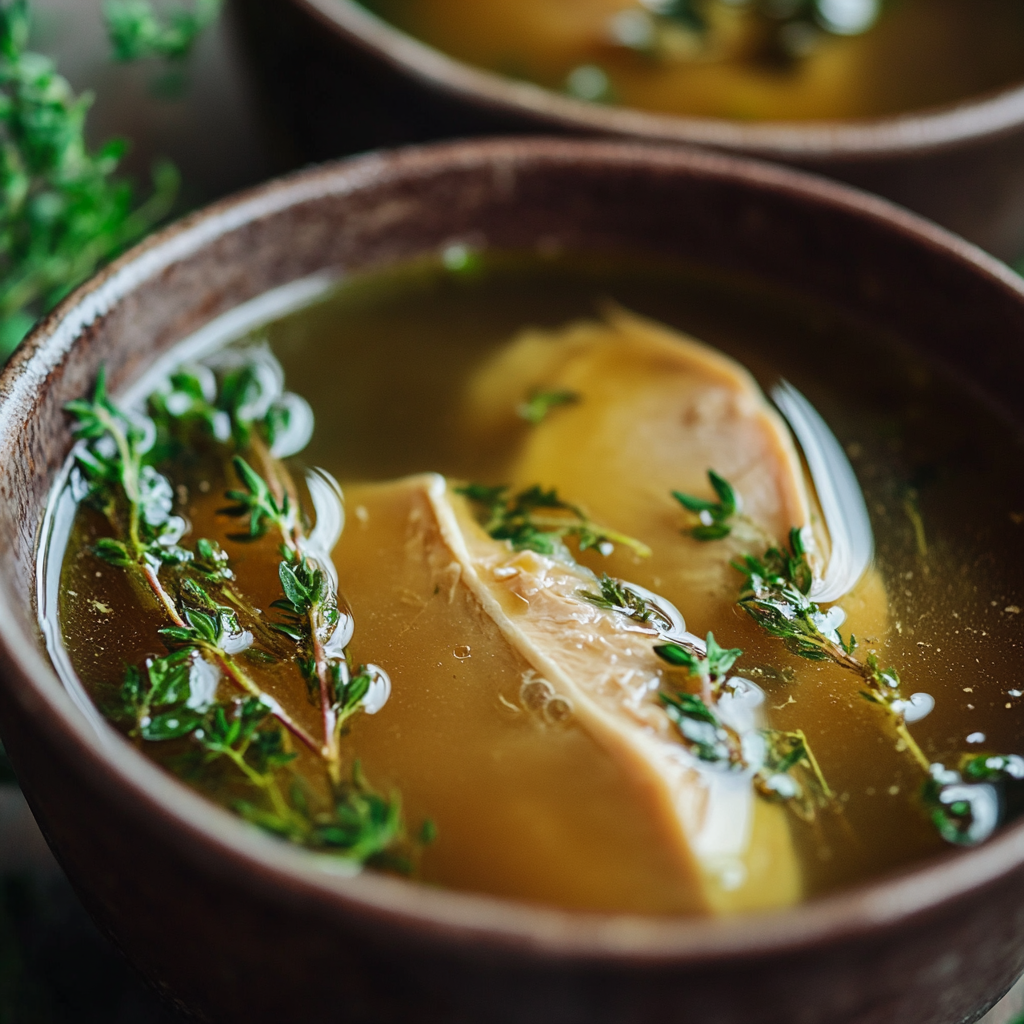Homemade Chicken Stock Recipe
Homemade chicken stock is a kitchen staple that elevates soups, stews, sauces, and a range of dishes with its deep, rich flavor. Making chicken stock from scratch ensures a fresher, more natural taste, free from artificial preservatives. While it takes some time, the process is simple and well worth the effort. Below, you’ll find a comprehensive guide to creating your own chicken stock at home.
Ingredients
Main Ingredients
- Chicken carcass or bones – from 1 whole chicken (or use leftover roasted chicken bones)
- Chicken wings or drumsticks (optional) – 2-3 for extra flavor and gelatin
- Cold water – 12 cups
- Onion – 1 large, peeled and quartered
- Carrots – 2, peeled and cut into large chunks
- Celery stalks – 2, cut into large pieces
- Garlic cloves – 3, crushed (optional)
- Bay leaves – 2
- Fresh thyme or parsley – a small bunch (about 5-6 sprigs)
- Peppercorns – 1 teaspoon
- Salt – to taste (optional, best added when using the stock)

Step-by-Step Instructions
Step 1: Prepare the Chicken and Vegetables
- Rinse the chicken carcass or bones under cold water to remove any excess blood or impurities.
- Prepare the vegetables by peeling and chopping the onion, carrots, and celery into large chunks. Crushing the garlic (if using) releases more flavor into the stock.
Step 2: Combine Ingredients in a Stockpot
- Place the chicken bones and optional meat into a large stockpot. Add the chopped onion, carrots, celery, garlic, bay leaves, thyme (or parsley), and peppercorns.
- Pour in the cold water until all the ingredients are submerged. Starting with cold water allows the flavors to slowly infuse as the temperature rises.
Step 3: Simmer the Stock
- Bring the pot to a gentle boil over medium-high heat. Once it reaches a boil, immediately reduce the heat to low to maintain a gentle simmer.
- Skim off any foam or impurities that rise to the surface with a spoon to keep the stock clear.
- Let the stock simmer uncovered for 4-6 hours. This slow cooking process extracts maximum flavor and nutrients from the bones and vegetables.
Step 4: Strain the Stock
- Remove the pot from heat and let it cool for a few minutes.
- Place a fine-mesh strainer or cheesecloth over a large bowl or pot and carefully pour the stock through it to strain out the solids.
- Discard the bones and vegetables, as they will have given all their flavor to the stock.
Step 5: Cool and Store
- Let the strained stock cool to room temperature. Once cooled, transfer the stock to airtight containers.
- Refrigerate for up to 5 days, or freeze in portioned containers for up to 3 months.

Serving and Storage Tips
- Serving: Use the stock as a base for soups, risottos, sauces, or to cook grains like rice or quinoa.
- Storage: When refrigerated, a good chicken stock will develop a jelly-like consistency due to the gelatin from the bones. Skim off any solidified fat before using or keep it for added richness in cooking.
- Freezing: Use freezer-safe containers or ice cube trays for portion control. Frozen stock is perfect for recipes that call for small amounts.
Helpful Notes
- Flavor Additions: To enhance your stock, consider adding a splash of apple cider vinegar at the beginning to help draw out minerals from the bones.
- Roasting the Bones: For a deeper, more robust flavor, roast the chicken bones in a 400°F (200°C) oven for 30 minutes before starting the stock.
- Clarifying the Stock: If you prefer a clear stock, whisk an egg white into the cold stock and bring it to a boil. The egg white will coagulate and trap particles, which can then be strained out.
Tips from Well-Known Chefs
- Chef Julia Child: “Never rush the simmering process. A slow, long simmer extracts flavors gently and deeply, resulting in a full-bodied stock.”
- Chef Thomas Keller: “Don’t forget to taste your stock once it’s done. You can always adjust seasoning later, but getting the depth of flavor right from the start is key.”
Frequently Asked Questions
1. Can I use raw chicken instead of just bones? Yes, using raw chicken parts like wings or drumsticks adds more flavor and body due to the extra meat and collagen.
2. Is it necessary to add salt to the stock? Not initially. This way, you can control the salt level when you use the stock in recipes.
3. How do I remove fat from the stock? Chill the stock in the refrigerator. Once cold, the fat will solidify on top and can be easily lifted off.
4. What if I don’t have fresh herbs? Dried herbs work too; just use a smaller amount (about 1/2 teaspoon for thyme or parsley).
5. Can I use vegetable scraps? Yes, onion skins, carrot peels, and celery leaves can all contribute to a richer stock and help reduce food waste.
6. How long can I simmer the stock? Simmering for up to 24 hours will result in an even richer stock, but 4-6 hours is enough for most purposes.
7. How do I make the stock less cloudy? Avoid boiling too vigorously and skim the impurities regularly to keep the stock clear.
8. Can I reuse the bones? No, after one use, the bones will have given up most of their flavor and nutrients.
9. Why should I start with cold water? Starting with cold water helps release more collagen from the bones, leading to a more gelatinous stock.
10. Can I make chicken stock in a slow cooker? Yes, set your slow cooker on low for 8-12 hours and follow the same steps for straining and storing.
With this guide, you’ll be able to prepare a versatile homemade chicken stock that’s perfect for a variety of dishes, providing depth and homemade comfort to your cooking.
